 With renewed energy we begin with what feels like a new part of our trip in Ushuaia. We have now reached the southernmost point of our trip and will only go north from now! The plan is to drive from here to Calgary in Canada to visit our friends Daan and Miriam. From Ushuaia that is at least 15,000 km through 12 countries and probably much further if we -just like in Africa- zigzag through the continent. We met travellers that ride from Ushuaia to Dead Horse in Alaska in only three months time, but that is a bit fast for us. With an average of 200 km per day and some daytrips here and there it will take us at least least six months and perhaps even longer. If we can, we want to be in Canada before the real winter weather.
With renewed energy we begin with what feels like a new part of our trip in Ushuaia. We have now reached the southernmost point of our trip and will only go north from now! The plan is to drive from here to Calgary in Canada to visit our friends Daan and Miriam. From Ushuaia that is at least 15,000 km through 12 countries and probably much further if we -just like in Africa- zigzag through the continent. We met travellers that ride from Ushuaia to Dead Horse in Alaska in only three months time, but that is a bit fast for us. With an average of 200 km per day and some daytrips here and there it will take us at least least six months and perhaps even longer. If we can, we want to be in Canada before the real winter weather.
It is sunny when we leave Ushuaia with a full tank, but soon the first dark clouds appear on the horizon. We put on our rain gear and drive towards the rain. The Patagonian wind is again blowing hard. We lean against the wind and ride through the pouring rain to the border with Chile. The already dull landscape around us, looks even more sad because of the rain. Lost in thought we ride on. I think about what we can eat tonight, who we need to e-mail or already think of a paragraph for the next blog post.
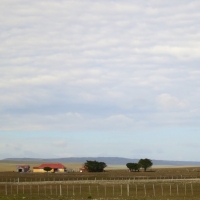 And as always I think of ’home’, of family and friends in the Netherlands that we have missed a little more around the holidays. You can imagine we were happily surprised when we heard that Peters parents will come and visit us. The last months we had looked into the possibilities for them to visit us and now it appeared that they had managed to rent a campervan. In one month they will fly from Amsterdam to Santiago, the capital of Chile. From there we travel together for five weeks through Argentina and Chile, we on the motorbikes and they in their campervan. What an adventure and how great that we will be able to share a part of our trip with them! Four weeks should be enough for us to drive from southern Argentina to Santiago to pick them up from the airport. Especially since we will largely ride the same route and will skip the places that we have already visited.
And as always I think of ’home’, of family and friends in the Netherlands that we have missed a little more around the holidays. You can imagine we were happily surprised when we heard that Peters parents will come and visit us. The last months we had looked into the possibilities for them to visit us and now it appeared that they had managed to rent a campervan. In one month they will fly from Amsterdam to Santiago, the capital of Chile. From there we travel together for five weeks through Argentina and Chile, we on the motorbikes and they in their campervan. What an adventure and how great that we will be able to share a part of our trip with them! Four weeks should be enough for us to drive from southern Argentina to Santiago to pick them up from the airport. Especially since we will largely ride the same route and will skip the places that we have already visited.
Wet from the rain and cold we arrive at the border at the end of the afternoon. We peel ourselves out of our rain suits and have the customs stamp all our papers. It is late and we do not feel like riding much further. But fortunately we do not have to, because only a few hundred meters after the customs office we find a room for the night at ‘Hostel La Frontera. A fresh bed, a hot shower and a plate of rice with chicken. Just right.
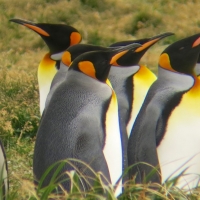 The next day we will take the ferry that takes us from Tierra del Fuego back to the Chilean mainland. The boat leaves at 19:00 and it is only 150 km to the port, so we have plenty of time to get there. At the end of the morning, we start the motorbikes. It is still too early for the boat of that night, but we make a detour and stop at Parque Penguino Rey, a small nature park where a colony of King penguins lives. From behind a wooden lookout we have a great view. The King Penguin is the little brother of the Emperor penguins that live on the Antarctica, but they are still much bigger than the penguins we saw in South Africa and Argentina. They have a black head and beautiful orange spots on their beak, head and chest. Truly a beautiful animal! They are in a large group closely together, some root with their beaks between their feathers and others waddle with small steps to the waterfront. It is like watching a live version of the “March of the Penguins.” Great! They are just too far away to take a detailed picture of their beautiful head with our small camera, but by holding the binoculars in front of the lens of the camera we can take a pretty good picture!
The next day we will take the ferry that takes us from Tierra del Fuego back to the Chilean mainland. The boat leaves at 19:00 and it is only 150 km to the port, so we have plenty of time to get there. At the end of the morning, we start the motorbikes. It is still too early for the boat of that night, but we make a detour and stop at Parque Penguino Rey, a small nature park where a colony of King penguins lives. From behind a wooden lookout we have a great view. The King Penguin is the little brother of the Emperor penguins that live on the Antarctica, but they are still much bigger than the penguins we saw in South Africa and Argentina. They have a black head and beautiful orange spots on their beak, head and chest. Truly a beautiful animal! They are in a large group closely together, some root with their beaks between their feathers and others waddle with small steps to the waterfront. It is like watching a live version of the “March of the Penguins.” Great! They are just too far away to take a detailed picture of their beautiful head with our small camera, but by holding the binoculars in front of the lens of the camera we can take a pretty good picture!
When we have looked at them from all angles, we get back on the motorbikes for the last stretch to the port. Like other parts of Tierra del Fuego, there are hardly any people here. Here and there are some lonely farms, plus a large flock of sheep, but we see hardly any other traffic. We drive a scenic route along the coast and again see whales and dolphins in the bay. At the end of the day we are back in Porvenir, where we join a long line of waiting cars. 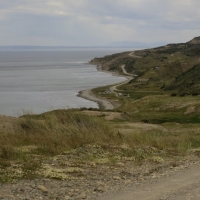 weWe meet Australian Andrew and Belgian Els who are also traveling by motorcycle to Punta Arenas. It takes a long time before the motorbikes are allowed to drive on the ferry and it is already dark when the boat finally starts moving. Only at 23:00 we arrive in Punta Arenas. We drive to the center and are warmly welcomed at Hostel Independencia where we had booked a double room.
weWe meet Australian Andrew and Belgian Els who are also traveling by motorcycle to Punta Arenas. It takes a long time before the motorbikes are allowed to drive on the ferry and it is already dark when the boat finally starts moving. Only at 23:00 we arrive in Punta Arenas. We drive to the center and are warmly welcomed at Hostel Independencia where we had booked a double room.
We will stay here a few days because Peter has to work on the motorbikes. He needs to change the oil and we need new tires. When we passed Punta Arenas on our way south, we had already searched for new tires, but at that time we did not find the right ones. In Ushuaia we had also visited some motorcycle shops, but in Argentina motorcycle parts are quite expensive and on the remote Tierra del Fuego even more so. Stuart and Nicola, our friends from the UK, had directed us to Alejandro in Punta Arenas. We should be able to buy ‘Heidenaus’ from him, a brand of tires we previously also used on our bigger bikes. When we left Amsterdam with the CRFs we used Mitas tires and although they were perfect for Africa, it seemed like they were eaten by the sharp gravel in South-America. The second set of tires did not last 26,000 km, but only 14,000 km. The tires of Heidenau seem to be a good alternative.
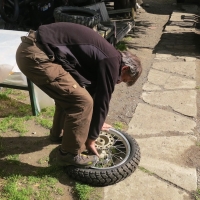 We find Alejandro the next day in his workshop where he is just bend over a huge BMW. In our best Spanish we ask if he can sell us tires. He has a lot of tires in stock and fortunately also the sizes we need. We put down a thick pile Chilean pesos and tie four new tires on our bikes. Back at the hostel, Peter directly starts to work. At the end of the day both motorbikes have new tires and a day later they also have new oil. We are ready to leave, but stay one more day for some other chores and also because we are having a good time in the hostel. Besides Andrew and Els, we meet Erik, a Belgian guy who saves up all his holidays and then wanders through South-America on his motorbike for a few months every other year. And we meet with Xenia and Xenia, two ladies from Switzerland who bought a cool campervan in the US which they drove to Ushuaia in a years time. At the small kitchen table in the hostel we listen to their stories and we take notes about the countries where we are still going.
We find Alejandro the next day in his workshop where he is just bend over a huge BMW. In our best Spanish we ask if he can sell us tires. He has a lot of tires in stock and fortunately also the sizes we need. We put down a thick pile Chilean pesos and tie four new tires on our bikes. Back at the hostel, Peter directly starts to work. At the end of the day both motorbikes have new tires and a day later they also have new oil. We are ready to leave, but stay one more day for some other chores and also because we are having a good time in the hostel. Besides Andrew and Els, we meet Erik, a Belgian guy who saves up all his holidays and then wanders through South-America on his motorbike for a few months every other year. And we meet with Xenia and Xenia, two ladies from Switzerland who bought a cool campervan in the US which they drove to Ushuaia in a years time. At the small kitchen table in the hostel we listen to their stories and we take notes about the countries where we are still going.
After three days in Punta Arenas, we hit the road again and we follow the Ruta del fin del mundo back to Puerto Natales, where we pitch our tent in the garden of a small hostel. The next morning we are still fast assleep when the alarm sounds, but we have a long day of more than 500 km ahead of us, so we have to get up. Silently, on autopilot we start to pack our stuff. Now we are on the road for over a year all items have their fixed place and we can almost fold the tent with our eyes closed. Mid-morning we cross the border into Argentina.
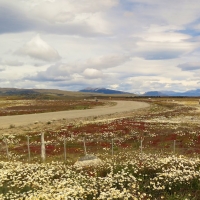 Back in Argentina we are also back on Ruta 40. Today the weather is nice, but fortunately cloudy. Not that we cannot appreciate the sun, but mostly because the clouds are so beautiful! They make the already vast landscape even more wide. The colours of the flowering shrubs and the snowy peaks of Torres del Paine National Park in the distance make the beautiful view complete. We drive past the exit to El Calafate, where we have already spend some time on the way south, but do stop at the viewpoint at Lago Viedma because we cannot just drive past the azure lake. At the other end of the lake we see thick clouds above the peaks of the Andes. Not a good sign, because that is where we are going.
Back in Argentina we are also back on Ruta 40. Today the weather is nice, but fortunately cloudy. Not that we cannot appreciate the sun, but mostly because the clouds are so beautiful! They make the already vast landscape even more wide. The colours of the flowering shrubs and the snowy peaks of Torres del Paine National Park in the distance make the beautiful view complete. We drive past the exit to El Calafate, where we have already spend some time on the way south, but do stop at the viewpoint at Lago Viedma because we cannot just drive past the azure lake. At the other end of the lake we see thick clouds above the peaks of the Andes. Not a good sign, because that is where we are going.
We drive along the lake to the west, full against the wind. The motorbikes use much more gasoline and only on the last drops of fuel we arrive in El Chalten. It is a small village with only a few hundred inhabitants, that is overrun each summer by tourists that have come to visit the beautiful nature in Los Glaciers National Park. Especially among climbers El Chalten is world famous because the village is the starting point for the ascent of Mount Fitzroy, one of the most technically challenging mountains to climb in the world! We are not going to climb, but do want to try out our new shoes and go hiking. Despite the blisters we did like moving some muscles the last time. And maybe we can even catch a glimpse of the legendary mountain peak.
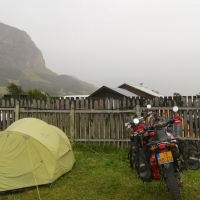 For now we cannot see anything of the mountains around us, because the valley is covered in a thick layer of fog. We find a camping spot at one of the campsites and pitch our tent in the pouring rain. Between two rain showers we prepare some food and then we crawl into our sleeping bags early. One day of 500km is quite tiring!
For now we cannot see anything of the mountains around us, because the valley is covered in a thick layer of fog. We find a camping spot at one of the campsites and pitch our tent in the pouring rain. Between two rain showers we prepare some food and then we crawl into our sleeping bags early. One day of 500km is quite tiring!
When we stick our heads outside the tent the next morning we face a gray wall of fog. We can only see a few hundred meters into the valley and still see no mountains. The wind blows hard and it is so cold that we want to crawl back into our sleeping bags again. Instead, we take all our stuff to the “refugio”, a large wooden cabin where all shivering campers have gathered. The space is filled with long tables, where hikers and climbers wait for better weather. While we have breakfast we hear from our table mates that they have been waiting here already for a week. They pass the time with a book or a game of cards and look at the weather forecast on their phones every fifteen mintues. Today, the weather will not improve, but it should be better tomorrow.
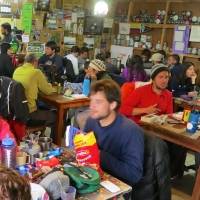 This means that we will not go hiking today. We decide to stay anyway because if it will indeed be better weather tomorrow we still can go hiking then. Moreover, we still have a little more than three weeks to arrive in Santiago to pick up Peters parents from the airport, plenty of time to stay here a day. We do some shopping and use the rest of the day to ‘work’ on the blog and the administration. It is busy in the refugio, especially in the communal kitchen where you have to put in some effort to find a spot for your pot on the stove. All in all a great day, after the long day yesterday.
This means that we will not go hiking today. We decide to stay anyway because if it will indeed be better weather tomorrow we still can go hiking then. Moreover, we still have a little more than three weeks to arrive in Santiago to pick up Peters parents from the airport, plenty of time to stay here a day. We do some shopping and use the rest of the day to ‘work’ on the blog and the administration. It is busy in the refugio, especially in the communal kitchen where you have to put in some effort to find a spot for your pot on the stove. All in all a great day, after the long day yesterday.
When we step out of the tent the next morning it unfortunately is just as gray as the previous morning. We will not go hiking today. We hear the waiting climbers complain that there will be at least two more days of bad weather. It was quite cozy in the refugio, but waiting two more days is a bit too long, so we decide to leave. Too bad because now we will not see Mt. Fitzroy. We pack up the tent in the pouring rain and leave the village. We follow the lake to the east and seem to fly now we have the wind in our backs. Once we are back on the main road, we drive in the sun and see the dark rain clouds become smaller in our mirrors.
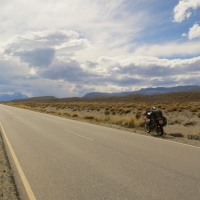 We follow Ruta 40 towards Tres Lagos, where we stop to refuel. From the station onwards the road is not asphalted and we will have to cover about 80 km on a bad gravel road. Normally that is not a problem, but today I am a little reluctant because my bike is not doing OK. From the moment we left Punta Arenas, I seem to feel every bump in the road. I told Peter that I was not so keen on the new tires and complained about the high tire pressure, but he assured me that he had not inflated the tires harder than usual. Yet it does not feel right. Every time we stop on the side of the road to take a picture, I feel horrible when I ride across a big rock by mistake. It gives a tremendous blow and it feels like I am breaking my bike.
We follow Ruta 40 towards Tres Lagos, where we stop to refuel. From the station onwards the road is not asphalted and we will have to cover about 80 km on a bad gravel road. Normally that is not a problem, but today I am a little reluctant because my bike is not doing OK. From the moment we left Punta Arenas, I seem to feel every bump in the road. I told Peter that I was not so keen on the new tires and complained about the high tire pressure, but he assured me that he had not inflated the tires harder than usual. Yet it does not feel right. Every time we stop on the side of the road to take a picture, I feel horrible when I ride across a big rock by mistake. It gives a tremendous blow and it feels like I am breaking my bike.
I am unable to explain the problem to Peter, but if we arrive at the fuel station in Tres Lagos and ride onto a gravel path to the pump I am sure there is something wrong. I get off the bike so that Peter can ride on my motorcycle and then tell him that my bike feels like the car of Kamal, our fixer in Egypt. Then Peter suddenly knows what the problem is, “Your shock!”. He does not even have to ride my bike to get confirmation that my shock absorber is broken, because when he pushed down the back of the bike it is immediately clear that there is no damping. We can also see that oil has leaked from the shock. No wonder that every ridge in the road felt like a high speed bump. This is not good news, because it means that I cannot continue. At least, not farther to the north on the gravel road that starts after Tres Lagos. I can still ride on asphalt, because otherwise I would stopped somewhere during the last 900(!) km we drove since Punta Arenas.
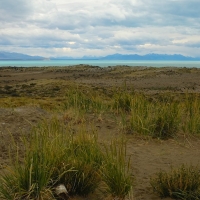 If we can find a pick up which can take my bike, maybe we can get a ride to just past the gravel and ride on the asphalt from there to a workshop. We wait a while at the gas station. Although there are a few pick-ups that come along, almost no one goes to the north and most of the pick ups already have motorbikes in the back. We even meet a German-American couple, Andy and Christy, who were making a tour through South-America on two motorcycles when she fell and broke her leg. Instead of cancelling the trip, they decided to hire a pickup and put their big BMW’s in the back to continue. The moment we meet them they are already travelling in the car for five weeks. Another week and then her cast will be taken off. They will then hand in the car to finish their trip on the motorbikes. Wow, that is resilience! Our problem with the shock suddenly feels a lot less severe.
If we can find a pick up which can take my bike, maybe we can get a ride to just past the gravel and ride on the asphalt from there to a workshop. We wait a while at the gas station. Although there are a few pick-ups that come along, almost no one goes to the north and most of the pick ups already have motorbikes in the back. We even meet a German-American couple, Andy and Christy, who were making a tour through South-America on two motorcycles when she fell and broke her leg. Instead of cancelling the trip, they decided to hire a pickup and put their big BMW’s in the back to continue. The moment we meet them they are already travelling in the car for five weeks. Another week and then her cast will be taken off. They will then hand in the car to finish their trip on the motorbikes. Wow, that is resilience! Our problem with the shock suddenly feels a lot less severe.
Because it does not look like we can get a ride, we decide to drive back on the paved road to El Calafate. That is a pretty big town where we might just find a workshop. We turn around and drive back to the south again. We pass the exit to El Chalten from where we came that morning and pass the azure colored Lago Viedma. Once in El Calafate we drive straight to the campground where we stayed last time.
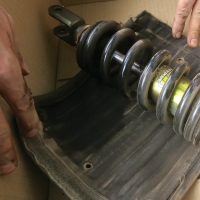 It is too late to start working on my bike now, but we can do some preparatory work. Peter wants to try to fix the shock himself (anything rather than standing next to a mechanic who might even now less about the shock than he does). Because he has not previously worked on our shock absorbers, he dives into his notes and already takes a look at the spare parts he had brought for the shock absorber. He also sends an email to Bas, our friend and shock absorber specialist at Hyperpro who supplied the shock absorbers for our motorbikes*** to ask him some technical questions. At the campsite it is too dusty to take apart the shock absorber and Peter does not have all the necessary tools. Tomorrow, we will therefore also look for a workshop where Peter can work. We translate some sentences into Spanish using Google Translate and hope that tomorrow we can properly explain the problem. It is very late that night when we turn off the light.
It is too late to start working on my bike now, but we can do some preparatory work. Peter wants to try to fix the shock himself (anything rather than standing next to a mechanic who might even now less about the shock than he does). Because he has not previously worked on our shock absorbers, he dives into his notes and already takes a look at the spare parts he had brought for the shock absorber. He also sends an email to Bas, our friend and shock absorber specialist at Hyperpro who supplied the shock absorbers for our motorbikes*** to ask him some technical questions. At the campsite it is too dusty to take apart the shock absorber and Peter does not have all the necessary tools. Tomorrow, we will therefore also look for a workshop where Peter can work. We translate some sentences into Spanish using Google Translate and hope that tomorrow we can properly explain the problem. It is very late that night when we turn off the light.
When we wake up the next morning we have received a long email from Bas. He describes step by step how Peter should take apart the shock absorber and how he can recognize which part is broken. Great! Peter uses the morning to remove the shock absorber from my bike and to clean it. Once the Argentine siesta is over, we go together in search of a workshop. Along the way, we also search for new oil and a machine with which the spring can be compressed to be able to remove it from the shock absorber.
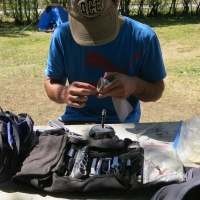 More than three hours we drive on Peters bike criss-cross through El Calafate, from workshop to mechanics and from stores to petrol stations. We go to at least 15 different addresses, unfortunately without any result. None of the stores or workshops have the oil we need and the only machine that we find to remove the spring does not work. Nor can we find a suitable workshop where Peter can work on the shock. It does not help that we hardly speak any Spanish, but much to our frustration the people we meet make hardly any effort to understand us. At the end of the day we have visited all the addresses that were in the GPS, but it looks like we will not be able to do the repairs in El Calafate. We drive back to the campsite and pass an industrial area where we see yet one other workshop. Let’s try there as well, you never know.
More than three hours we drive on Peters bike criss-cross through El Calafate, from workshop to mechanics and from stores to petrol stations. We go to at least 15 different addresses, unfortunately without any result. None of the stores or workshops have the oil we need and the only machine that we find to remove the spring does not work. Nor can we find a suitable workshop where Peter can work on the shock. It does not help that we hardly speak any Spanish, but much to our frustration the people we meet make hardly any effort to understand us. At the end of the day we have visited all the addresses that were in the GPS, but it looks like we will not be able to do the repairs in El Calafate. We drive back to the campsite and pass an industrial area where we see yet one other workshop. Let’s try there as well, you never know.
We walk to the door with the shock absorber and call a greeting inside. We hear a voice that invites us inside. Once we are in the workshop we are received by a big, friendly smiling man that holds his arms wide in the air calling: “Bienvenidos Amigos !!”(Welcome friends!). We meet Mario, the owner of the workshop. It appears to be a workshop where mostly ‘turbos’ of cars are repaired. Mario does not know anything about motorcycles or shock absorbers, but does ask how he can help us. When we ask whether Peter could work on the shock absorber here, Mario immediately instructs one of his employees to clear a corner. He shows Peter where the tools are and shows him all the oil he has. If we then ask whether he has a machine to remove the spring from the shock, he takes us in his car to a nearby garage where they remove the spring within two minutes. 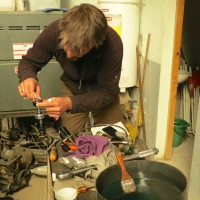 Then he drives with us to the center of El Calafate to go to at least six other stores to ask whether they sell the oil we need.
Then he drives with us to the center of El Calafate to go to at least six other stores to ask whether they sell the oil we need.
We do not find the right oil, but now the spring is off Peter can at least start working. It is seven o’clock in the evening when we are back in the workplace and agree with Mario to come back the next day to continue working on the shock absorber. Mario will then also help us again to look for the right oil. After a disappointing morning during which we only hear “No” over and over again, the day ends unexpectedly positive. Delighted we drive back to the campsite. What a difference to meet someone like Mario!
The next morning we take the email Bas sent us and go to work. I read the instructions from the iPad while Peter disassembles the shock absorber. We keep taking pictures, so we will be able to put it back together again afterwards. We do not want to finish the job with some screws in our hands. To make sure that everything is going well, Peter calls in a ’helpline’ when he calls Bas on Skype to ask him some questions. Mario regularly looks over Peters shoulder. He makes sure that Peter has all the tools he needs, he has oil to lubricate parts and rags to clean things.  Together with his son Santty he also ensures that we have food and drinks. While Peter is working very hard, I am having a great time in the garage. I practice my Spanish with Santty and hug their woolly puppy Turbo.
Together with his son Santty he also ensures that we have food and drinks. While Peter is working very hard, I am having a great time in the garage. I practice my Spanish with Santty and hug their woolly puppy Turbo.
The problem turns out to be a worn seal, a small rubber ring in the shock absorber. A part that we should have replaced preventively after 20,000 km when servicing the shock. It had now already been in the shock for more than 40,000 km(!). Luckily we brought new seals. At the end of the day the seal is replaced and the shock absorber is back together. Now we only have to fill the damper with oil. And that cannot just be any oil, but should be special thin ‘fork oil’. We did find some fork oil in El Calafate, but that oil is too thick with which the shock would not work. Mario therefore asks a befriended courier to search for the oil in Rio Gallegos, a big town on the coast. If he is able to buy the oil there, Peter can fill the shock tomorrow and then we will be off again.
After two days of hard work it is first time for some fun. Mario has invited us for an asado at his home. With the Argentine BBQ at Jorge La Posta still fresh in our memories, we cannot say ’no’ to that invitation. Mario sends Santty to the local supermarket for beer (according to Mario not “cerveza” but “birra” as the Italians say),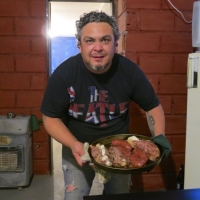 while he himself is in the kitchen grilling meat. After an hour he comes out with a big bowl of salad and an even larger plate with meat. It tastes great! Mario sends Santty to the supermarket a few more times during dinner for more ’birra’, until the slightly stronger drink is served: Fernet Branca. Luckily we had a proper meal! Our Spanish improves with every sip and we really have a great evening! We thank him profusely and agree that we return to the garage the next afternoon when the courier has returned from Rio Gallegos.
while he himself is in the kitchen grilling meat. After an hour he comes out with a big bowl of salad and an even larger plate with meat. It tastes great! Mario sends Santty to the supermarket a few more times during dinner for more ’birra’, until the slightly stronger drink is served: Fernet Branca. Luckily we had a proper meal! Our Spanish improves with every sip and we really have a great evening! We thank him profusely and agree that we return to the garage the next afternoon when the courier has returned from Rio Gallegos.
The following afternoon, the courier arrives back in El Calafate empty-handed. There is no choice but to order the oil via the internet. That will take a few days, but that is OK. With the help of Mario, we buy exactly the right oil in a garage in Buenos Aires through Mercado Libre, the South American version of Ebay. We can use a fast courier service to have the package send to El Calafate, but that is quite expensive. A cheaper option is a regular parcel service, which is provided by the bus companies that drive through the country. It will take a little longer, but according to Mario no more than three days. Even if we stop for another three days we will still have enough time to drive to Santiago to pick up our visitors from the airport, so we choose the ordinary parcel service. In the meantime, there are plenty of other chores to do.
The next day we go to Mario to see how things are going with ordering the oil. It then appears that things are going a little slower that we had thought yesterday. There has been contact with the seller in Buenos Aires, but before he will send the oil it must be paid first. 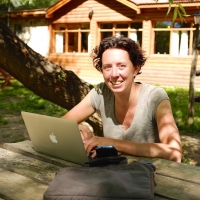 Paying amounts by using online banking is not very common here, so Mario must go to the post office in El Calafate to pay in cash, which amount can then be collected by the seller at the post office in Buenos Aires. Only when the seller has the money, he will send the oil and as it looks like that is only going to happen tomorrow. The three days we would wait for the oil, have just become five.
Paying amounts by using online banking is not very common here, so Mario must go to the post office in El Calafate to pay in cash, which amount can then be collected by the seller at the post office in Buenos Aires. Only when the seller has the money, he will send the oil and as it looks like that is only going to happen tomorrow. The three days we would wait for the oil, have just become five.
In the days that follow, we stay at the campsite where we do all kinds of jobs. Peter repairs the tent and my sleeping mat and works on his own motorbike as well. Meanwhile I try to find the best WiFI Signal with the computer to work on the website. After we waited four days, we again contact Mario. The oil must be arriving in El Calafate any day now. Unfortunately, we find out that the seller, after he had received the money, had waited another two days to send the parcel. We will therefore have to wait at least two more days. Now we are beginning to worry a bit about the arrival of our visitors. It is still quite a long drive to Santiago and we have less and less time for that.
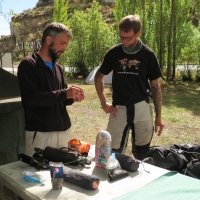 We kill time by going to the hairdressers, by going for a ride along the lake and by walking through the village. I can always do plenty of work on the blog, but all Peters chores are now done so he has begun a reading marathon. And we spend a lot of time with other motorcycle travellers we meet on the campsite. We share a bottle of wine with Erik and Pascal, two “motards” from Belgium. We meet Alex from Germany who is riding his Vespa from Alaska to Ushuaia. We eat hamburgers with John from the UK who took an early retirement and has already been on the road for seven years. We talk about our beloved Africa with Michael and Claudia from Germany. We meet Gustavo, an Argentine who like us travels on a small motorcycle through South America. We enjoy the sun with Andrew, Els and Jesse, travellers we had also meet in the deep south. We meet 68 year old German Johan, who just passed his motorcycle license a month ago, bought a motorcycle and immediately began a journey through Chile and Argentina. And we have very nice time with Bea and Helle from Germany who have been traveling on two Honda Transalps around the world for the last three years. It is really great to meet so many like-minded people and it makes up for the long time that we have to wait!
We kill time by going to the hairdressers, by going for a ride along the lake and by walking through the village. I can always do plenty of work on the blog, but all Peters chores are now done so he has begun a reading marathon. And we spend a lot of time with other motorcycle travellers we meet on the campsite. We share a bottle of wine with Erik and Pascal, two “motards” from Belgium. We meet Alex from Germany who is riding his Vespa from Alaska to Ushuaia. We eat hamburgers with John from the UK who took an early retirement and has already been on the road for seven years. We talk about our beloved Africa with Michael and Claudia from Germany. We meet Gustavo, an Argentine who like us travels on a small motorcycle through South America. We enjoy the sun with Andrew, Els and Jesse, travellers we had also meet in the deep south. We meet 68 year old German Johan, who just passed his motorcycle license a month ago, bought a motorcycle and immediately began a journey through Chile and Argentina. And we have very nice time with Bea and Helle from Germany who have been traveling on two Honda Transalps around the world for the last three years. It is really great to meet so many like-minded people and it makes up for the long time that we have to wait!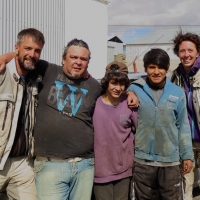
We maintain contact with Mario. He finds it equally annoying that he has to keep telling us time and again that the oil is still on its way to El Calafate. Before we know it, we have waited another few days until it is weekend again. But then on Monday afternoon we finally receive the long awaited message that the oil has arrived in El Calafate! Mario has already picked it up from the post office, so we can drive directly to the workshop. When we arrive, he holds the can up the the air smiling! With the instruction of Bas at hand, we fill the oil shock. Peter then fills the shock with air to the right pressure and tests the shock absorber. That looks good! Now he only has to place back the spring, but that must wait until the next day because the garage that has the machine to do it is already closed.
Back at the campsite we already start packing our bags so we can leave the next day once the work is done. The next morning Mario takes us to the adjacent garage where the spring is put back within a few minutes. We pay the friendly garage owner and then ask for the bill to pay Mario. We pay him for the oil and shipping, but he does not want anything for his help and the use of the garage! Instead of giving him money we do give him “birra” and a bottle of Fernet Branca, with which he is very happy. 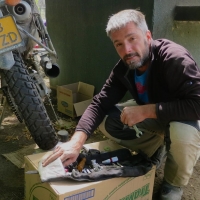 We must unfortunately decline his invitation for a second asado, because we really want be in time in Santiago to meet Peters parents, so we really have to leave. We thank Mario a thousand times for his help, take one last picture and then say goodbye. Amigo!
We must unfortunately decline his invitation for a second asado, because we really want be in time in Santiago to meet Peters parents, so we really have to leave. We thank Mario a thousand times for his help, take one last picture and then say goodbye. Amigo!
Back at the campsite Peter builds the shock back into my bike, while I pack the tent and the rest of our stuff. After an hour I hear, “OK, ready for the big test.” Peter pushes down the back of my bike and instead of the hard noise we heard at first, my bike now nicely moves up again. It is working, great! In total we stopped in El Calafate for 15 days, but now we can hit the road again! And we will be riding some long days, because we now only have seven days to arrive in Santiago and that is still 2,700 km away! Let’s GO!
Back on Ruta 40 we also ride along Lago Viedma again. And although it is the fourth time that we look out over the beautiful lake, the view is even better this time than all previous times. It is sunny and the entire mountain range on the other side is visible, even Mount Fitzroy! Nice to have seen the pointy top after all! We drive past the exit to El Chalten and stop again in Tres Lagos to refuel. The driveway to the station gives no problems this time, what a relief that everything has been fixed.
That evening we stop in Gobernator Gregoris where we camp on the free municipal site. Although we left late this morning, we still managed to drive 333 km today. A good start. The next morning the alarm clock already rings at 06:00 o’clock and instead of turning around one more time, we begin to pack our stuff. We eat a big breakfast, pack the tent and set off for another marathon ride. We drive from fuel station to fuel station, where we do not only refuel but also to stretch our legs and eat some food. The next time we stop is when we start looking for a place to stay.
From Gobernator Gregoris we ride to Perito Moreno and the next day to Bariloche. It has been two months since we were in Bariloche and it now is summer. The snow on the mountain tops has melted, the roofs of convertibles are open and the terraces are full. Our warm clothing, which we were still wearing only a few days ago in Patagonia, is now tucked away in our bags and exchanged for shorts and slippers. The route from Bariloche to the north is beautiful and leads past blue lakes, a beautiful canyon and a deep green forest. At the end of the afternoon we ride through Lanin National Park to the border with Chile. It is a small but very beautiful nature park with high Monkey Puzzle Trees.
Once in Chile, we ride into National Park in Villa Rica and we are back in the land of volcanoes! We sleep that night in Pucon, at the foot of the volcano Villarica. We then have another three days to ride to Santiago, but we end up riding two long days on the highway. With a reward, because the next day no alarm goes off and no need to pack the tent. And as a bonus our bums get a day of rest!
The next day we get back on the bikes early that morning to ride to the airport. Today our visitors arrive!! We are happy, excited and also a little nervous because what will it be like for them to travel like we do? And what will it be like to travel together for the next five weeks? We manage to find a good spot in the arrivals hal and impatiently wait until the plane has landed. And then suddenly there they are: Ton and Marijke, the parents of Peter!  Really great to see them after such a long time! Their adventure immediately begins, because after an exciting taxi ride from the airport to the city center, they pick up their campervan and follow us right through the city center to the campsite. And that is just the beginning!
Really great to see them after such a long time! Their adventure immediately begins, because after an exciting taxi ride from the airport to the city center, they pick up their campervan and follow us right through the city center to the campsite. And that is just the beginning!
Distance travelled to Santiago: 45.132km (28.044 miles)
Click here to see the pictures.
***See “Recipe for an adventure bike” about the shock absorber and suspension that were fitted on our motorbikes by Bas and David.
Previous story “The end of the world” – Next story “Colourful Mountains“





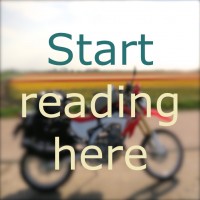


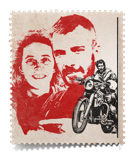
Wat een verhaal van die schokbreker zeg! Ben heel benieuwd naar jullie verhalen samen met de ouders van Peter. Grappig dat ze er zelf ook benieuwd naar zijn, hihi.
Ohhh hebben jullie condors gezien? Die pinguins zijn cool zeg. En grappig dat een turbomonteur zijn puppy turbo noemt Ben blij dat jullie weer rijden, Liefs!
Ben blij dat jullie weer rijden, Liefs!
Viva Mario!! Wat zijn dat toch een bijzondere ontmoetingen met die mensen die een helpende hand bieden!Dikke knuffel xxx
Wat een pech dat jullie zo lang hebben moeten wachten. Spannend ook, want jullie wisten niet of en wanneer het goed ging komen.
Liefs van ons.
Weer een prachtig verslag van jullie belevenissen. We kijken nu vol verwachting uit naar de volgende hoofdstukken, waarin onze gezamenlijke belevenissen te lezen zullen zijn van jullie prachtige reis, samen met ons, langs en over het Andesgebergte. Liefs vanuit Frankrijk.
Hoi Leonie en Peter,
Wat een verhaal weer, en dat door 1 oliekeerringetje dat uiteindelijk de reis moe was.
Ik hoop dat jullie de reis nog niet moe zijn en nog veel moois mogen ontdekken.
Dat vrije gevoel op de motor is natuurlijk heerlijk en dan nog in die mooie weide wereld.
Nog heel veel plezier en wij genieten graag nog met jullie mee.
Joke en Janleen
Tof om weer te lezen. Graag zou ik bij jullie aankomst in NL zijn tzt. Goeie reis!! En die Bas is ook een gouden vent.Maar dat wisten wij al jaren.
Spannend verhaal! Veel liefs van ons xxx
Very impressed that you got to service your shock yourself. Thanks for sharing we are taking notes 😀